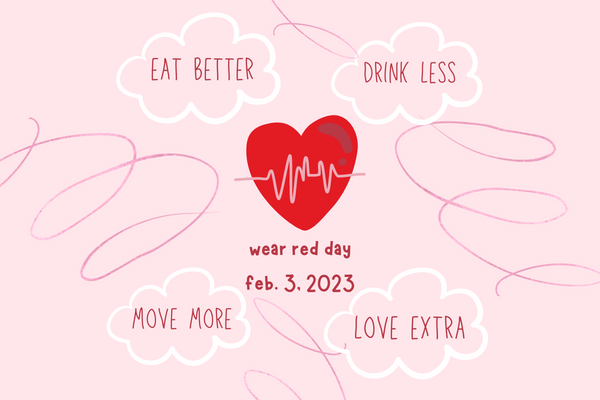One of our country’s leading causes of death is also one of the most preventable chronic diseases.

Let’s Wear Red for CVD!
As the number of deaths attributed to cardiovascular disease increased in the late ‘90s, the American Heart Association found a need to create a greater awareness and resource pool for what would soon become the number one cause of death in women. The Go Red for Women campaign launched almost twenty years ago to develop a more strategic approach for the care of women with cardiovascular disease (CVD).
February is about heart-healthy living; it’s about creating and implementing a lifestyle that includes understanding your genetic risk, but mostly evaluating your habits when it comes to movement, diet, and stress management, and making heart-healthier choices.
We know of certain lifestyle and genetic factors which contribute to CVD: smoking, living a sedentary lifestyle, family history, diabetes, stress, various inflammatory diseases, complications during pregnancy, and menopause. We also know eating whole foods, moving more, managing our stress, and having a consistent relationship with our medical providers (aka getting regular screenings, etc) can help reduce that risk. What we often forget about is the other kind of “heart health…” the friendships, the growth, the accomplishments in life which fuel you mentally and emotionally!
For years, doctors believed it was solely the patient’s response to “feeling down” that led to increased risk of CVD. For example, if you are stressed or feeling depressed and you reach for the ice cream or a cigarette or binge watch three seasons of Seinfeld, doctors believed it was only those actions that increased your risk. More and more research conducted over the last decade or so points to the physiological response of stress and depression as also being factors. Quite often, it is a sense of feeling alone and isolated, unsupported, without purpose, and unaccomplished that begin the physiological response. And yes, these are also triggers for potentially participating in unhealthy habits or actions, the same habits and actions that also increase risk.
The PERMA model can guide us through a growth process to not only improve our mental and emotional well-being, but also support a "bigger picture" with our heart health. Creating space to experience positive emotions, generate engagement, foster healthy relationships, discover meaning in your life and current situation, and feel accomplished for the big and small things supports your mental and emotional well-being. Your physiology is then not only supported by your physical actions and habits but also your mental and emotional habits, growth, connections, etc. The Go Red campaign touches on all of the above, as we band together for a purpose, creating relationships and engaging in a support network that understands how cardiovascular disease impacts our lives.
With that said, it is time to ignite a wave of red across the nation as we shine the spotlight on heart health. This year’s theme is “Be the Beat” - inspiring us to lead by example and show our community what it looks like to elevate our health.
Can you think of one simple step you can take TODAY to help your heart beat better, tomorrow? It starts with personal responsibility, because what we do to create our own well-being will inevitably affect those around us. Consider the actions below to kickstart your journey to a happy heart, based on the top behavioral risk factors for chronic illness.
Challenge a loved one to see who can try one new fruit or vegetable each week this month. The “winner” gets dinner on the “loser”!
Make a goal to increase the number of steps you average daily by 500 for the month of February. Add 500 more next month!
Next time you have a night out (or in!) with friends, try the alcohol-free version of your favorite drink. Not only will you likely feel more present, but you’ll cut a few calories out of the original recipe too!
Wear red on February 3rd, and “Be the Beat” by empowering those around us to do the same.
